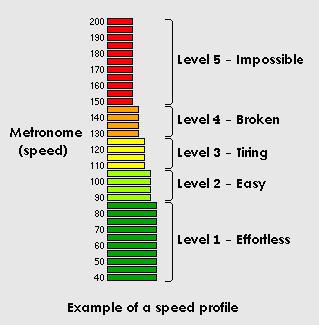Guitar Speed Trainer
The Guitar Speed Method For Developing
Superior Speed And Technique
This image shows one of the "secrets" of . Can
you guess what it is?

OK, that was a difficult one... Let's start from the beginning:
Imagine playing a musical phrase, starting slowly, and then gradually
going faster and faster.
Naturally, at a slow speed you will play better, and as you keep going
faster, the quality of your playing will gradually decrease.
So imagine describing the quality of your playing on the following
scale:
"The Five Quality Levels Below"
Level 1. Effortless -- you can play it in your sleep.
Level 2. Easy --
you can play it well, but you must be careful and pay attention.
Level 3.
Tiring -- you can play it for a while, but you soon get tired and
start making mistakes.
Level 4. Broken -- you can only play fragments of the
phrase, here and there.
Level 5. Impossible -- you just can't play it at all
at this speed.
The quality of your playing could then be displayed in a graphic, like this:
The Speed Profile

This is a Speed Profile and it describes quality or
sensation of your playing
performance at various speeds.
Knowing your own speed profile is the first step, the first "secret"
to of
developing serious speed and technique.
And the next step is...
"This Is It! The 7 Classes Of Phrasing,
Practice Methods"
Now, obviously, some musical phrases are easier to play than others.
For example, it's much easier to play a linear series of notes on the same
string than a complex phrase where you must continuously jump from one string to
another.
In fact there are seven classes of musical phrases that should be
measured and exercised separately. They are:
"How To Practice"
(Use Steps 1, 2, 3, & 4, Perfect
1 Before You Go To 2, 3, 4, Etc.)
Class 1. "Single" -- This is when you play the same note repeatedly, using only downstrokes
or only upstrokes. This is your basic picking motion speed, your "bottom line"
speed (perfect this one before you go to the next).
Class 2. "Double" -- This is when you play the same note with alternating down-
and up-strokes. In theory this speed should be twice the previous one, but in
practice it's less than that. (And one of the goals of training is to bring as
near as possible to that point) (perfect this one before you go to the next).
Class 3. "Chromatic" -- This is when you play adjacent notes one after the
other. This is more difficult (and therefore slower) than the previous one
because now the left hand has to move, although in a simple way, in sync with
the right hand (perfect this one before you go to the next).
Class 4. "Scale" -- This is when you play a scale or a simple phrase on
successive strings. This is one notch more difficult than a chromatic run on the
same string as in the previous class (perfect this one before you go to the
next).
Class 5. "Pattern" -- This is when you play a lick or a scale pattern,
or some repetitive phrase. Again, this is one notch more difficult than the
previous, "linear" scale phrases.
Class 6. "Random" -- This is when you play a non-repetitive and
unfamiliar phrase. While scales and patterns use well-practiced finger
movements, a generic, "random" phrase, has to be created and controlled on
the spot, and that makes it the most difficult of all phrases.
Class 7. "Burst" -- This is when you play a short run, passage, or
trill, at the highest possible speed. While all other classes of phrasing
ultimately derive from class 1 (single), the speed burst is on a class of its
own and requires specific training and attention.
Above Information GuitarSpeed.com


